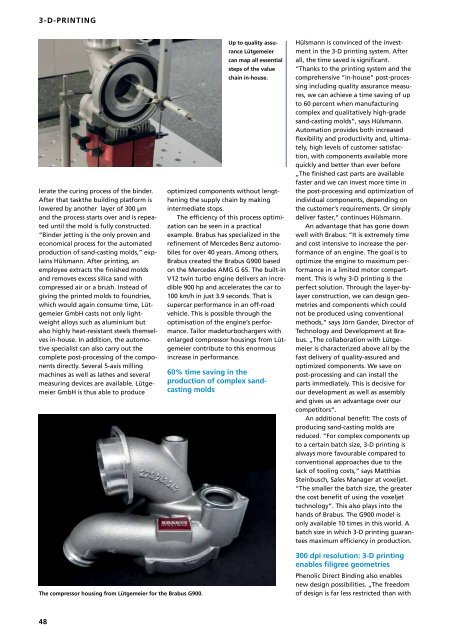CPT International 4/2019
You also want an ePaper? Increase the reach of your titles
YUMPU automatically turns print PDFs into web optimized ePapers that Google loves.
3-D-PRINTING<br />
lerate the curing process of the binder.<br />
After that taskthe building platform is<br />
lowered by another layer of 300 µm<br />
and the process starts over and is repeated<br />
until the mold is fully constructed.<br />
“Binder jetting is the only proven and<br />
economical process for the automated<br />
production of sand-casting molds,” explains<br />
Hülsmann. After printing, an<br />
employee extracts the finished molds<br />
and removes excess silica sand with<br />
compressed air or a brush. Instead of<br />
giving the printed molds to foundries,<br />
which would again consume time, Lütgemeier<br />
GmbH casts not only lightweight<br />
alloys such as aluminium but<br />
also highly heat-resistant steels themselves<br />
in-house. In addition, the automotive<br />
specialist can also carry out the<br />
complete post-processing of the components<br />
directly. Several 5-axis milling<br />
machines as well as lathes and several<br />
measuring devices are available. Lütgemeier<br />
GmbH is thus able to produce<br />
Up to quality assurance<br />
Lütgemeier<br />
can map all essential<br />
steps of the value<br />
chain in-house.<br />
optimized components without lengthening<br />
the supply chain by making<br />
intermediate stops.<br />
The efficiency of this process optimization<br />
can be seen in a practical<br />
example. Brabus has specialized in the<br />
refinement of Mercedes Benz automobiles<br />
for over 40 years. Among others,<br />
Brabus created the Brabus G900 based<br />
on the Mercedes AMG G 65. The built-in<br />
V12 twin turbo engine delivers an incredible<br />
900 hp and accelerates the car to<br />
100 km/h in just 3.9 seconds. That is<br />
supercar performance in an off-road<br />
vehicle. This is possible through the<br />
optimisation of the engine’s performance.<br />
Tailor madeturbochargers with<br />
enlarged compressor housings from Lütgemeier<br />
contribute to this enormous<br />
increase in performance.<br />
60% time saving in the<br />
production of complex sandcasting<br />
molds<br />
Hülsmann is convinced of the investment<br />
in the 3-D printing system. After<br />
all, the time saved is significant.<br />
“Thanks to the printing system and the<br />
comprehensive “in-house” post-processing<br />
including quality assurance measures,<br />
we can achieve a time saving of up<br />
to 60 percent when manufacturing<br />
complex and qualitatively high-grade<br />
sand-casting molds”, says Hülsmann.<br />
Automation provides both increased<br />
flexibility and productivity and, ultimately,<br />
high levels of customer satisfaction,<br />
with components available more<br />
quickly and better than ever before<br />
„The finished cast parts are available<br />
faster and we can invest more time in<br />
the post-processing and optimization of<br />
individual components, depending on<br />
the customer‘s requirements. Or simply<br />
deliver faster,“ continues Hülsmann.<br />
An advantage that has gone down<br />
well with Brabus: “It is extremely time<br />
and cost intensive to increase the performance<br />
of an engine. The goal is to<br />
optimize the engine to maximum performance<br />
in a limited motor compartment.<br />
This is why 3-D printing is the<br />
perfect solution. Through the layer-bylayer<br />
construction, we can design geometries<br />
and components which could<br />
not be produced using conventional<br />
methods,” says Jörn Gander, Director of<br />
Technology and Development at Brabus.<br />
„The collaboration with Lütgemeier<br />
is characterized above all by the<br />
fast delivery of quality-assured and<br />
optimized components. We save on<br />
post-processing and can install the<br />
parts immediately. This is decisive for<br />
our development as well as assembly<br />
and gives us an advantage over our<br />
competitors“.<br />
An additional benefit: The costs of<br />
producing sand-casting molds are<br />
reduced. “For complex components up<br />
to a certain batch size, 3-D printing is<br />
always more favourable compared to<br />
conventional approaches due to the<br />
lack of tooling costs,” says Matthias<br />
Steinbusch, Sales Manager at voxeljet.<br />
“The smaller the batch size, the greater<br />
the cost benefit of using the voxeljet<br />
technology”. This also plays into the<br />
hands of Brabus. The G900 model is<br />
only available 10 times in this world. A<br />
batch size in which 3-D printing guarantees<br />
maximum efficiency in production.<br />
The compressor housing from Lütgemeier for the Brabus G900.<br />
300 dpi resolution: 3-D printing<br />
enables filigree geometries<br />
Phenolic Direct Binding also enables<br />
new design possibilities. „The freedom<br />
of design is far less restricted than with<br />
48

















